Cigar Union Strategy
A National Cigar History Museum Exclusive
Text & Images © Tony Hyman, All rights reserved

Cigar Union Strategy
A National Cigar History Museum Exclusive
Text & Images © Tony Hyman, All rights reserved
The CigarMaker’s International Union was an aggressive fighter for worker’s rights. Though losing most strikes, they were able to pioneer union staples such as traveling loans, regulated workdays, sick benefits and other innovations. More successful was their focus on their “Blue Label,” which in September 1880 became the nation’s first national Union stamp. The Union tightly regulated who could use it, but repeatedly urged those who could to place it on every box of cigars made in union shops. The Union invested in pins, buttons, and a wide range of other give-aways calling attention to the Union Label, urging members of all trade unions to honor the label by purchasing cigars only from boxes that displayed it.

In addition to buttons, the CMIU gave away useful items by the score. This small combination notebook and mini-almanac is a good example of Union message and strategy. It’s small enough to fit in an overall pocket, and contains useful information to encourage carrying it there. 1917 and 18 calendars, blank pages, and a list of Union and non-Union brands make up the most of the balance. Prominent on pages 2 and 3 is a plea against patronizing a local Detroit cigar brand.
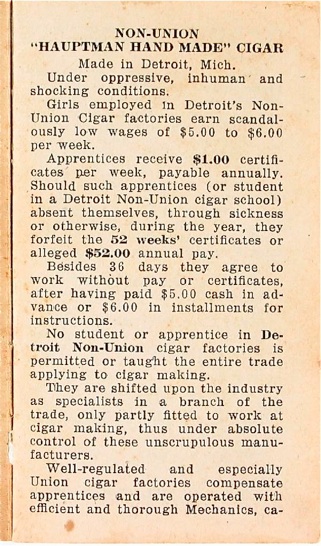
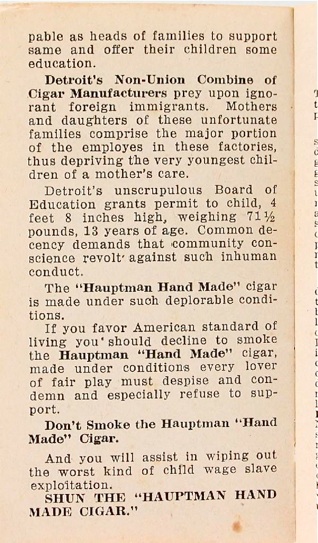
A late 1950s manifestation when their culprit was later machine made in PA.
RIGHT: pages listing popular brands sold in St. Louis but made in NY, NJ, MI, OH, PA and IN. Circles highlight errors or typos resulting in wrong states, tax districts or factory numbers.
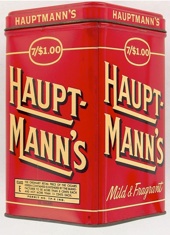
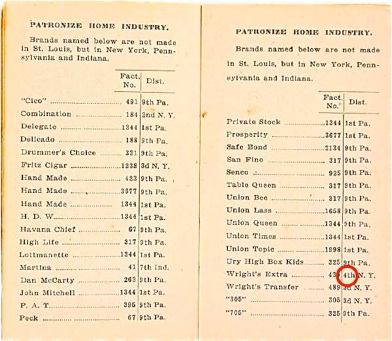
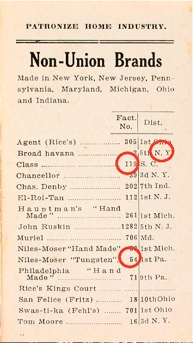
Ever since the passage of the Pure Food and Drug Act in 1906 the nation had a heightened awareness of sanitation. Although lobbyists had successfully removed tobacco from the list of regulated products, cleanliness had been an issue in the cigar industry since the last quarter of the 19th century, thanks to the serious campaign against tenement house cigar factories conducted by the government, a rising star NY politician named Theodore Roosevelt, and the Cigar Maker’s Union. Sanitation and child labor became cornerstones of the Union early, and continued into the machine age and the Union’s inevitable decline and demise.


In the 1800’s, the Union’s chief enemy was tenement house factories employing women and children working under appalling conditions in their flats. Their next crusade was against the Tobacco Trust. Unlike the tenements which were a primarily a New York City problem, the Trust impacted Union members around the country. Many of the celluloid give-aways seen in another Museum exhibit reflect the vigor and direction of that campaign. With the Trust’s break-up in 1911, the chain stores, especially United Cigar Stores, the retail arm of the technically dissolved trust, became a prime concern. They had good reason to fear United Cigar with its endless premiums and price-cutting, thousands of stores stocked with a variety of related notions, situated in prime urban locations, usually on corners of busy streets.
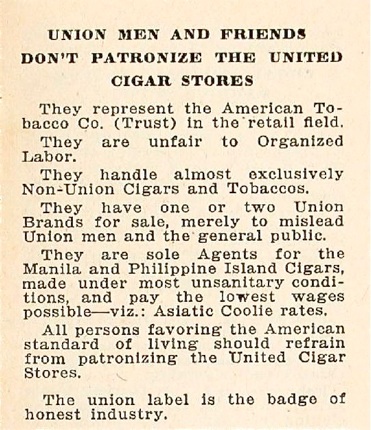
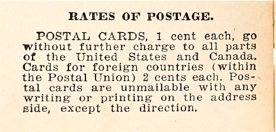
The battle against United lasted many decades, with both sides ultimately disappearing, United killed by the depression, the Union by machinery and its
own inability to adjust to changes in the industry.
One of the informational tid-bits in this 1917 booklet, was this sad reminder of where we once were. Of course, none of us wants 1917 wages, just their postal rate.